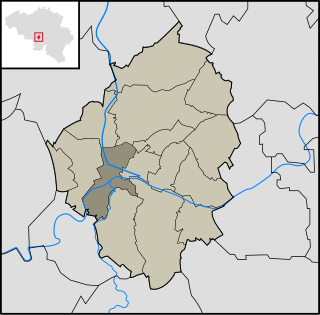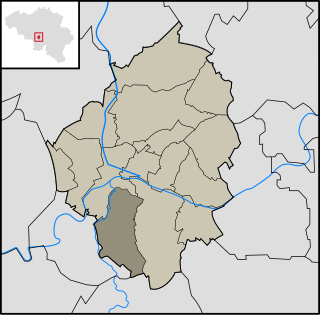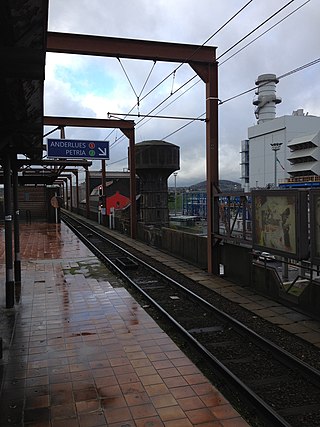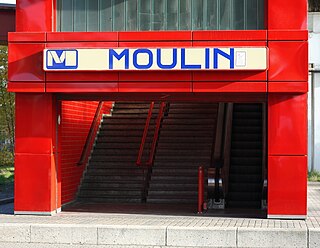
The Battle of Fleurus, on 26 June 1794, was an engagement during the War of the First Coalition, between the army of the First French Republic, under General Jean-Baptiste Jourdan, and the Coalition army, commanded by Prince Josias of Coburg, in the most significant battle of the Flanders Campaign in the Low Countries during the French Revolutionary Wars. Both sides had forces in the area of around 80,000 men but the French were able to concentrate their troops and defeat the First Coalition. The Allied defeat led to the permanent loss of the Austrian Netherlands and to the destruction of the Dutch Republic. The battle marked a turning point for the French army, which remained ascendant for the rest of the War of the First Coalition.

Charleroi is a city and a municipality of Wallonia, located in the province of Hainaut, Belgium. The city is situated in the valley of the Sambre, in the south-west of Belgium, not far from the border with France. By 1 January 2008, the total population of Charleroi was 201,593. The metropolitan area, including the outer commuter zone, covers an area of 1,462 square kilometres (564 sq mi) with a total population of 522,522 by 1 January 2008, ranking it as the 5th most populous in Belgium after Brussels, Antwerp, Liège, and Ghent. The inhabitants are called Carolorégiens or simply Carolos.
Cockerill-Sambre was a group of Belgian steel manufacturers headquartered in Seraing, on the river Meuse, and in Charleroi, on the river Sambre. The Cockerill-Sambre group was formed in 1981 by the merger of two Belgian steel groups – SA Cockerill-Ougrée based at Seraing in the province of Liège, and Hainaut-Sambre based at Charleroi in the province of Hainaut – both being the result of post-World War II consolidations of the Belgian steel industry.

The arrondissement of Avesnes-sur-Helpe is an arrondissement of France in the Nord department in the Hauts-de-France region. It has 151 communes. Its population is 230,372 (2016), and its area is 1,407.5 km2 (543.4 sq mi).

R. Olympic Charleroi Châtelet Farcienness, is a Belgian association football club from the city of Charleroi, Hainaut. As of 2019, they play in the Belgian National Division 1.

Marchienne-au-Pont is a town of Wallonia and a district of the municipality of Charleroi, located in the province of Hainaut, Belgium.

Mont-sur-Marchienne is a town of Wallonia and a district of the municipality of Charleroi, located in the province of Hainaut, Belgium.
Cartier Castle is a château in Marchienne-au-Pont, a district of Charleroi, in the province of Hainaut, Wallonia, Belgium.
Monceau Castle can refer to a château in the following places in Belgium:
Forges de la Providence was a Belgian steel producing company based in the Hainaut region around Charleroi. Founded as Société Anonyme des laminoirs, forges, fonderies et usines de la Providence the company had three steel production sites at Marchienne-au-Pont in Belgium, and Réhon and Hautmont in France.

Thy-Marcinelle is a steelworks in Charleroi, Belgium, a subsidiary of the Riva group. The company is the descendant of one part of various steel companies based in the Charleroi industrial basin. Its history traces back through Cockerill-Sambre to the predecessors of Hainaut-Sambre, the companies Thy-Marcinelle et Monceau and Thy-Marcinelle et Providence.

Providence is a Charleroi Metro station, build on a viaduct and located in Marchienne-au-Pont, Belgium, in fare zone 1. The station has only one entrance, equipped with escalators and stairs.

De Cartier is a Charleroi Metro station, located in the center of Marchienne-au-Pont, in fare zone 2. It is an underground station featuring a central platform with escalator and stairs access at both ends.

Moulin is a Charleroi Metro station, located on the border of Marchienne-au-Pont and Monceau-sur-Sambre, in fare zone 2. The station is built on a viaduct and features a central platform with escalator and stairs access at the western end, leading to two separate street accesses.

Morgnies is a Charleroi Metro station, build at ground level and located in Goutroux, in fare zone 2. The station has only one entrance, equipped with escalators and stairs.

The Battle of Gosselies or Battle of Charleroi saw a Republican French army co-commanded by Jacques Desjardin and Louis Charbonnier try to cross the Sambre River against a joint Dutch and Habsburg Austrian army under William, Hereditary Prince of Orange. The French defeat in the battle marked the third of five attempts by their armies to win a foothold on the north bank of the Sambre during the War of the First Coalition. In 1794, Gosselies was a separate village but is now part of the Charleroi municipality, about 7 kilometres (4 mi) north of the city center. Charleroi is located about 60 kilometres (37 mi) south of Brussels.

The Battle of Lambusart saw a Republican French army led by Jean Baptiste Jourdan try to cross the Sambre River against a combined Dutch and Habsburg Austrian army under William VI, Hereditary Prince of Orange. This battle was the culmination of the fourth of five attempts to consolidate a foothold on the north side of the Sambre. The clash occurred during the War of the First Coalition, part of a wider struggle known as the Wars of the French Revolution. In 1794, Lambusart was an independent village, but it is now part of the Fleurus municipality. Lambusart is located about 10 kilometres (6 mi) northeast of Charleroi.

The Waterloo campaign commenced with a pre-emptive attack by the French Army of the North under the command of Napoleon Bonaparte. The first elements of the Army of the North moved from their peacetime depots on 8 June to their rendezvous point just on the French side of the Franco-Belgian border. They launched a pre-emptive attack on the two Coalition armies that were cantoned in Belgium—the Anglo-allied army under the command of the Duke of Wellington, and a Prussian army under the command of Prince Blücher.



![Castle of Monceau-sur-Sambre [fr] (17/18th centuries) Chateau de Monceau-sur-Sambre - 2022-02-12 - 01.jpg](http://upload.wikimedia.org/wikipedia/commons/thumb/6/60/Ch%C3%A2teau_de_Monceau-sur-Sambre_-_2022-02-12_-_01.jpg/220px-Ch%C3%A2teau_de_Monceau-sur-Sambre_-_2022-02-12_-_01.jpg)













